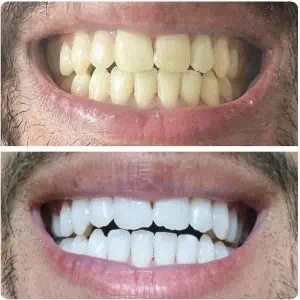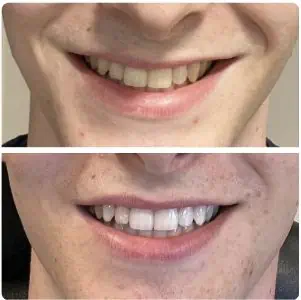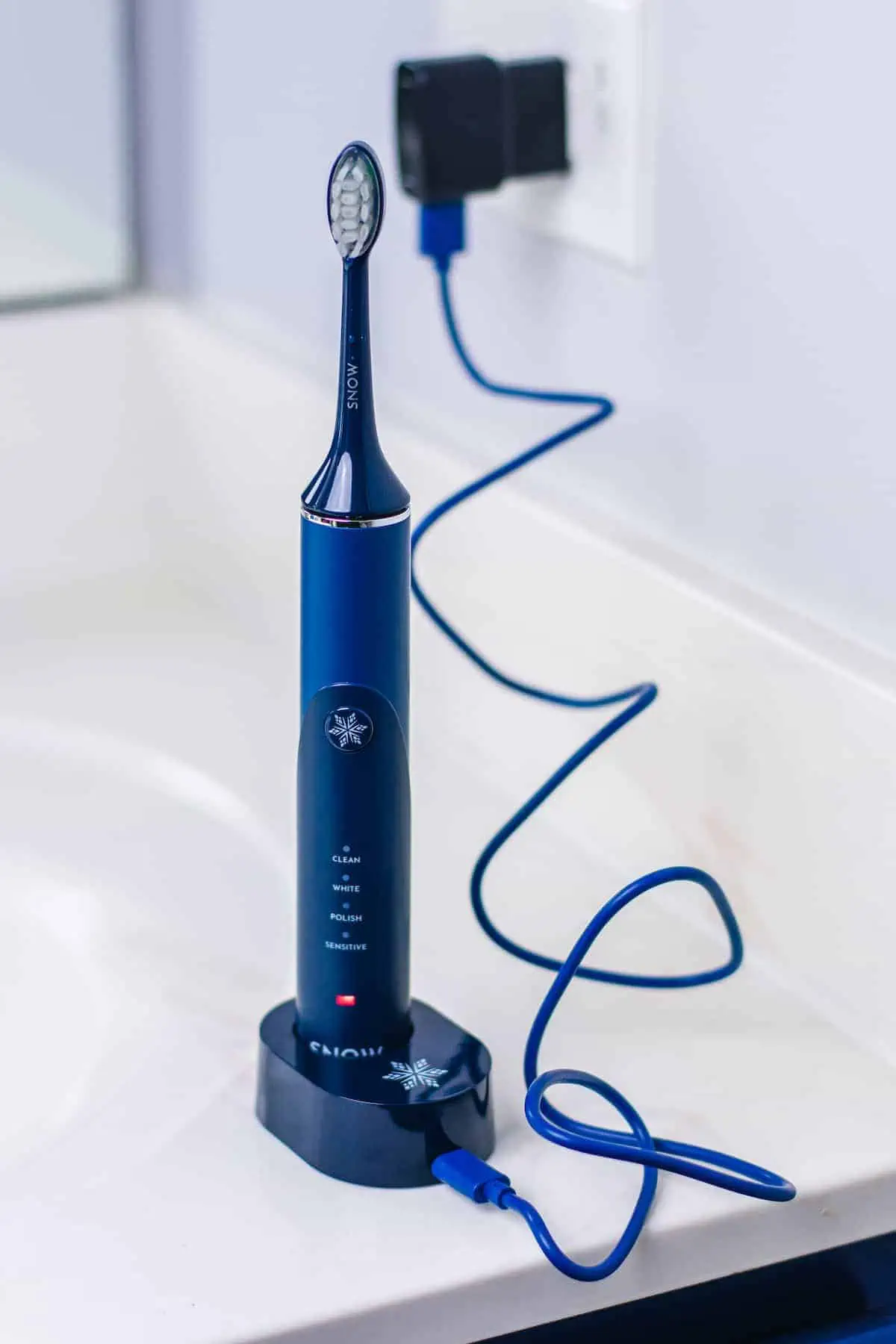Do you have brown stains on your teeth? Are you concerned about what causes brown teeth, despite your efforts to keep up oral hygiene?
You’re not alone! Brown staining is a widespread issue, but there’s good news! Making a few lifestyle adjustments or using teeth whitening treatments may remove them.
These marks range in colour from yellowish-brown to black-brown, and the stains might take the shape of marks, spots, dots, streaks, or lines.
In this article, we’ll take a look at some causes of brown stains on teeth and answer the following questions and more:
- What causes brown stains, spots, and lines on teeth?
- How to remove brown stains from your teeth
- How to get rid of brown stains in between your teeth
- What are the best teeth-whitening methods for brown stains?
Keep reading to learn more about these and other aspects of brown teeth.
There are multiple ways how to remove brown stains from teeth naturally at home, which include brushing with activated charcoal, baking soda mixed with lemon juice, using hydrogen peroxide, or apple cider vinegar mixed with water. However, before trying these, consult your dentist, to determine the causes of your brown stains and the best treatment for your needs.
Want to know how to get rid of brown stains on teeth fast? The best option would be to schedule a professional teeth cleaning and whitening at your next dentist-visit. If you’re looking for good a teeth whitening product, we recommend trying out the Smile White teeth whitening kit.
Types of brown stains on teeth
Brown marks on teeth might be obvious, but others might be barely detectable. They come in a variety of shades from nearly yellow to dark brown. Some brown spots appear as dots, while others appear as lines.
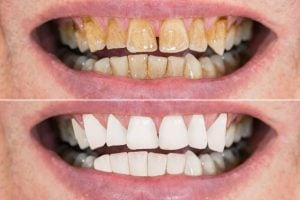
What causes brown stains on teeth?
Brown stains between teeth may be from a variety of factors such as nicotine and tobacco, dark-coloured foods and beverages, medications, trauma, celiac disease, enamel hypoplasia, or natural ageing.
Nicotine & tobacco
Tobacco is a frequent cause of brown teeth. Nicotine may be present in a variety of tobacco products, including:
- Cigarettes
- Cigars
- Pipe tobacco
- Chewing tobacco
- Vaping
These contain particles that may adhere to the tooth enamel’s small pores. The particles accumulate over time and may stain the teeth. The stains tend to darken and become more difficult to remove with time.
Foods and beverages with a dark colour
What you eat and drink may cause tooth discolouration, including brown, grey, and yellow stains. This is due to the presence of chromogen molecules in many dark-coloured foods and beverages.
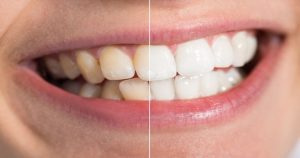
In addition to that, foods like wine, coffee, tea, soda, and dark chocolate contain tannic acid, which makes the chromogens more sticky and speeds up the formation of the brown stuff on teeth.
Coloured substances may leave spots and marks on the enamel. These stains might become permanent over time, especially if the person has poor oral care. Artificially coloured foods and beverages may also cause considerable discolouration of the teeth.
Here’s a list of foods and drinks that can cause your teeth to turn brown over time:
Medications
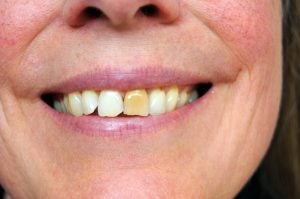
Teeth turning brown can also be caused by antibiotics like tetracycline and doxycycline. This is particularly likely to happen in youngsters who are still growing their teeth. It may also be passed on to children if their mother took them while pregnant.
Brown stains on teeth may also be caused by the medicine glibenclamide (Glynase), which is used to treat permanent neonatal diabetes mellitus.
Antihistamines, high blood pressure drugs, and antipsychotic medications are all known to stain teeth. It goes without saying that you should never stop taking a prescription medication just because it is staining your teeth.
Root canal
A root canal is required when the pulp of one of your teeth dies. This may cause a tooth to become brown and remain brown. It’s due to the darkening of the dead root, which has permeated the tooth.
Trauma
A tooth’s nerve may be damaged by trauma to the mouth. The tooth may develop brown spots or become entirely brown as a consequence.
If your traumatised tooth is still alive and well, it will most likely return to its original colour between two and six months after the damage. Teeth bleaching can be utilised to restore your teeth’s whiteness if they do not return to their normal colour.
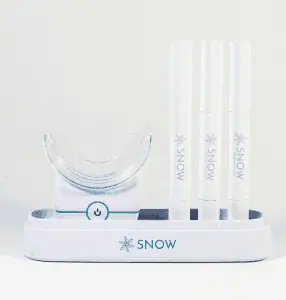
- Our #1 Teeth Whitening Kit
- Snow offers lasting results in just 9 minutes a day and satisfaction guaranteed or your money back.
- Fast Results: Noticeably whiter teeth after just one use, with full results in 21 days.
- Safe for Sensitive Teeth: Designed to be pain-free, even for those with sensitivity.
- Easy to Use: A convenient and straightforward application process.
- Celebrity Endorsed: Trusted and used by celebrities for a brighter smile.
Enamel hypoplasia
Teeth with less enamel than necessary may be caused by genetic or environmental reasons. Enamel hypoplasia is the medical term for this condition.
Enamel hypoplasia may be caused by a variety of factors, including:
- Deficiencies in vitamins
- Illness in the mother during pregnancy
- Exposure to toxins
Enamel hypoplasia may damage one or more teeth, causing brown or yellow stains to appear.
Tartar
Plaque is formed when bacteria in the mouth mix with food and saliva to form a sticky, transparent coating. When plaque isn’t removed regularly, it may harden and develop into tartar. Tartar may be yellow or brown in appearance and occurs at the gum line. Brown plaque on teeth may actually be tartar that appears brown in colour.
Brushing our teeth with toothpaste and flossing is usually enough to keep plaque levels under control. However, after tartar has formed, it can only be removed by a dentist.
Apart from poor oral hygiene, the following factors might cause the development of tartar:
- Use of nicotine (smoking, chewing tobacco, cigars)
- Hormonal changes, such as those that occur during pregnancy, puberty, and menopause
- Medicines that reduce the levels of saliva in the mouth, like nerve blockers or management medications for AIDS
- Diabetes
Tooth decay
The sugars you consume provide food for plaque and tartar bacteria. They also produce acids that erode enamel. Plaque and tartar have a thick, filmy structure that causes acids to attach to the teeth for lengthy periods of time.
The yellow layers of the tooth underneath become increasingly evident when the acids degrade the enamel. The teeth may seem yellowish-brown as a result. If the tooth decay is severe enough, the acids may penetrate the tooth and produce a hole or cavity.
Even little fractures and breaks in the teeth may allow germs to enter and cause decay. When bacteria pass through the cracks of dental fillings or crowns, many patients get brown spots of decay.
Previously completed dental work
Metal, silver, or white fillings that have deteriorated over time may discolour teeth. Surface stains on white fillings might cause the tooth to appear brown.
Celiac disease
Celiac disease may cause enamel issues in the teeth. Brown stains on the teeth are not uncommon in celiac disease patients.
Fluorosis
Fluorosis is a dental issue that alters the appearance of the teeth. Excessive exposure to fluoride within the first eight years of life triggers it, when fluorosis-affected people’s teeth may seem slightly stained once they come in.
However, if fluorosis is severe, the tooth enamel fractures and brown spots appear. Severe fluorosis is uncommon.
Because of the hypomineralisation of enamel, teeth with fluorosis might be compromised, making them potentially weaker than teeth without fluorosis. This may lead to tooth decay and make teeth turn brown in the long run.
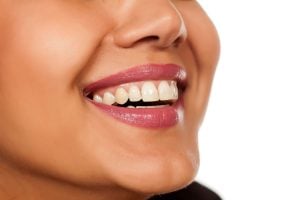
Natural ageing
It’s natural for people’s teeth to darken or to develop brown spots as they become older. This may be triggered by several causes that accumulate over time, including:
- Surface staining from foods and drinks high in chromogens and tannic acid.
- The enamel is thinning and the dentin becomes visible. It’s the layer of the tooth underneath the enamel. When the protective layer (enamel) on the dentin wears away, the teeth become sensitive to hot and cold because the nerves and cells within the tooth are activated. The dentin has a darker colour, which can be another reason for brown teeth.
Early symptoms of brown teeth
Look for the following signs and symptoms:
- Brown spots on teeth near gums
- Brown stains between teeth
- Brown lines on teeth
- Brown spot on front tooth
- Brown plaque on teeth
Brown spots on teeth may be an early symptom of dental cavities, which must be treated by a dentist. Symptoms such as tooth discomfort, sensitivity, or bad breath may accompany them.
Gingivitis may develop if tooth decay becomes severe. Consult a dentist if brown spots are accompanied by bleeding or painful gums regularly.
The teeth of people with enamel hypoplasia may have a rough surface or brown spots.
How to prevent brown stains on teeth
Maintaining good oral hygiene can help keep your teeth white, brilliant, and free of brown stains. After eating or drinking staining foods or beverages, clean your teeth with good toothpaste.
Here are some suggestions for preventing brown spots on teeth:
Quit smoking
Smoking is among the most common causes of brown stains on teeth, and nothing will make your smile yellow faster than this bad habit. There are hundreds of reasons to stop smoking, and one of them is to prevent your teeth from turning brown.
After consuming certain foods and beverages, rinse your mouth or brush your teeth
Unfortunately, a variety of foods and drinks have the potential to discolour our teeth. These include wine (both white and red), tea and coffee, soda, dark fruits, beets, soy sauce, and many more.
If a meal can stain your hands or clothing, it’s likely to stain your teeth as well! Therefore, if you eat foods that stain often, you should consider washing your mouth with water or mouthwash afterwards or brushing your teeth to avoid brown spots.
Cleanings and oral exams should be done routinely
Teeth cleaning on a regular basis may help you maintain a white smile. A teeth cleaning maintains a healthy mouth and removes plaque, which may pick up surface stains and give your teeth a whiter appearance. It’s recommended to get your teeth cleaned once or twice a year.
How to remove brown stains from teeth
Wondering how to remove brown stains from teeth? It’s often easier said than done to restore your bright white smile.
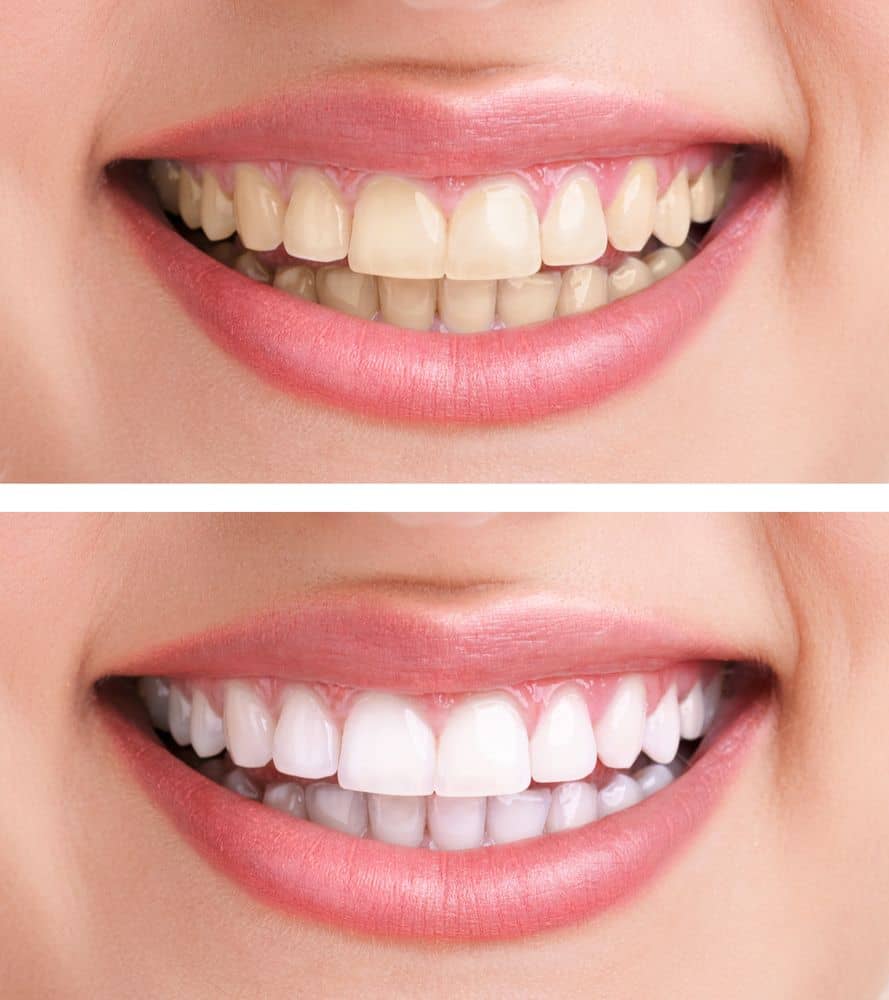
treatments for removing brown
stains?
So, how do I get rid of brown spots on teeth?
First and foremost, unless your dentist advises differently, you should see your dentist every six months for a cleaning that may involve scaling if needed. Scaling your teeth entails eliminating tartar build-up and cleaning the surfaces of your teeth using specialised equipment.
Your teeth may be considerably whiter after a professional cleaning — depending on the state they were in beforehand. However, if you want more significant results, you’ll need to consider your teeth whitening possibilities.
Professional in-clinic teeth whitening
In-clinic whitening, which is usually done by professionals under the instruction of a dentist, is a favourite option among many for eliminating brown stains from teeth.
Before teeth whitening, a patient’s teeth and gums are carefully cleaned, followed by the application of a bleaching agent. At the completion of the treatment, UV light or an argon laser may be used.
You can consider this a very safe method since the process is done under the professional guidance of dentists. This method is more expensive, but it enables you to quickly remove even the most persistent brown spots.
Best Whitening Toothbrushes | ||
Snow LED Whitening Electric Toothbrush |
| |
Oral-B 3D White Action Power Toothbrush  |
| |
Colgate 360 Degree Advanced Optic White Toothbrush  |
| |
AquaSonic Black Series Ultra Whitening Toothbrush 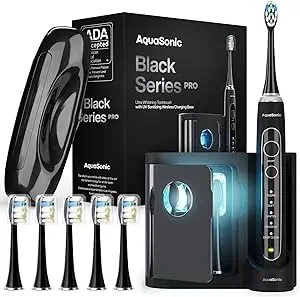 |
| |
Home whitening products
Surface stains may be possible to remove with at-home whitening procedures. However, whitening procedures may not work for all tooth discolourations.
You can buy teeth-whitening pens, strips, bleaching trays, and other home-whitening LED kits to brighten your smile. It’s important to follow the directions on these products in order to get the most out of them.
To have the optimum benefits, they should be used on a regular basis (meaning once per year or following packaging instructions). However, don’t use them too often or continuously since they might wear down your tooth enamel.
Home remedies
There are also a few home cures that might help you whiten your brown teeth. Watch this video to learn more ways how to remove brown stains from teeth naturally.
Conclusion
Brown stains on our teeth may result from a number of causes, including enamel weakening or plaque accumulation. If your teeth are in good shape but you want them to be whiter, there are several options available, including professional whitening, home whitening kits, and whitening toothpaste.
Keep in mind that you should see a dentist on a regular basis so that any buildup on your teeth can be removed before the stains become more severe.
Treatment type | Pros | Cons |
Professional teeth whitening | Fast and effective results | Expensive |
Home whitening kits | Lower cost; variety of treatments (strips, pens, etc.) | To get good results you have to be persistent |
Home remedies | Cheap | Results are not dramatic and take time |
FAQ
How do I remove brown stains from teeth?

Enamel staining is not permanent and may be quickly restored with professional stain removal and teeth whitening procedures. Home cures should be used with caution since they might be abrasive.
How do I remove brown stains between teeth?
A dentist can remove plaque and tartar off the surface of the teeth, and in between the teeth with a manual or ultrasonic scaler. There are also home remedies like brushing teeth with soda and water.
How do I get rid of brown spots on teeth?
To get rid of brown spots, brush your teeth with soda and water, or use tooth whitening toothpaste. However, professional treatment with a scaler and bleaching is more effective.
healthline.com: Brown Spots on Teeth. Consulted 24th October 2022.
medicalnewstoday.com: What to do about brown spots on your teeth. Consulted 24th October 2022.





